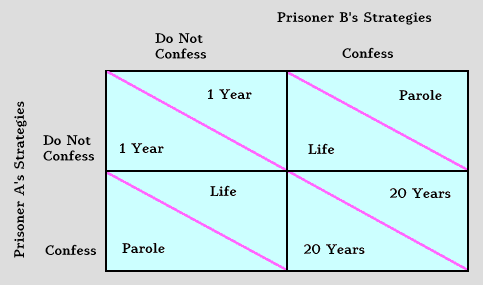The Prisoner's Dilemma
The prisoner's dilemma is the story of two criminals who have been arrested for a heinous crime and are being interrogated separately. Each knows that if neither of them talks, the case against them is weak and they will be convicted and punished for lesser charges. If this happens, each will get one year in prison. If both confess, each will get 20 years in prison. If only one confesses and testifies against the other, the one who did not cooperate with the police will get a life sentence and the one who did cooperate will get parole. The table below illustrates the structure of payoffs.

Given this set of payoffs, there is a strong tendency for each to confess, which you can be see by considering the choices and payoffs of either one. If prisoner A remains silent, prisoner B is better off confessing (because parole is better than a year in jail). However, B is also better off confessing if A confesses (because 20 years is better than life). Hence, B will tend to confess regardless of what A will do; and by an identical argument, A will also tend to confess.
The prisoner's dilemma is a case in which actions determined by self-interest are not in the group's interest (where the group is defined to include only the criminals, not the larger society). It is a story that would have pleased Thomas Hobbes, a political theorist of the mid-17th century. Hobbes is a grandparent of economics because he introduced into intellectual discussion two assumptions: first, that the individual is the starting point of social analysis, and, second, that people are motivated by self-interest. He believed that the unrestrained pursuit of self-interest would result in chaos and that government, with its power to coerce people, was necessary to bring order out of chaos.
Copyright Robert Schenk